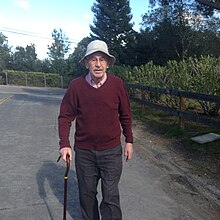Ian R. Gibbons
Ian Read Gibbons[2] | |
|---|---|
 | |
| Born | 30 October 1931[3] |
| Died | 30 January 2018 (aged 86)[2] |
| Nationality | British |
| Alma mater | University of Pennsylvania King's College, Cambridge |
| Known for | Research in dynein |
| Spouse | Barbara Gibbons (1961 to 2013) |
| Children | 2[4] |
| Awards | Shaw Prize in Life Science and Medicine (2017) International Prize for Biology (1995) E.B. Wilson Medal (1994) |
| Scientific career | |
| Fields | Biophysics Cell biology |
| Institutions | University of California, Berkeley University of Hawaiʻi at Mānoa Harvard University |
| Doctoral advisor | John Bradfield[1] |
Ian Read Gibbons, microtubules. In 2017, he and Ronald Vale received the Shaw Prize for their research on microtubule motor proteins.[6]
He was elected a Fellow of the Royal Society of Great Britain in 1983. The Society stated:
- He discovered, named and characterised the founding member of the dynein ATPase family of motor proteins and other microtubular components in cilia and flagella. By elegantly combining biochemical techniques with light and electron microscopy, he greatly advanced our understanding of microtubule-based motility, particularly by the direct visual demonstration of active dynein-dependent sliding between adjacent microtubules in structurally weakened flagella.[7]
Early life and education
Gibbons's passion for science stemmed from his interest in radio. He entered
chromosomes during mitosis and meiosis. Gibbons then went to the University of Pennsylvania as a postdoctoral researcher, where he stayed for 1 year. He subsequently moved to the Department of Biology, Harvard University, to take up the post of director of the newly founded electron microscopy laboratory.[1][4]
Academic and research career
While at
nucleotides while the latter with adenine nucleotides,[11] but refrained from naming it; Hideo Mohri from the University of Tokyo named it tubulin afterwards.[1]
Gibbons moved to the Kewalo Marine Laboratory,
dyneins, and determined the DNA sequence of the largest subunit of dynein in 1991.[15] In 1993, he became the director of the Kewalo Marine Laboratory.[4]
Ian and Barbara Gibbons retired from the University of Hawaiʻi at Mānoa in 1997; he went to the
Honours and awards
- Shaw Prize in Life Science and Medicine (2017)[6]
- International Prize for Biology, Japan Society for the Promotion of Science (1995)[16]
- E.B. Wilson Medal, American Society for Cell Biology (1994)[17]
- Fellow of the Royal Society (1983)[18]
- Guggenheim Fellowship in Molecular and Cellular Biology, John Simon Guggenheim Memorial Foundation (1973)[19]
Personal life
Gibbons met his wife Barbara while in Harvard University; they married in 1961.[1] Barbara died in 2013 at age 81.[20] Gibbons also died in 2018.[2]
References
- ^ ISBN 978-0-12-809471-6.
- ^ a b c d Sanders, Robert (14 February 2018). "Sunday (18 Feb.) memorial service for prize-winning biologist Ian Gibbons". Berkeley News. Retrieved 22 October 2018.
- ^ a b Gibbons, Ian R. (26 September 2017). "Autobiography of Ian R Gibbons". Shaw Prize Foundation. Archived from the original on 11 July 2018. Retrieved 22 October 2018.
- ^ a b c d e Sanders, Robert (25 May 2017). "Ian Gibbons awarded Shaw Prize for discovery of molecular motors". Berkeley News. Retrieved 28 October 2018.
- .
- ^ a b "Announcement of The Shaw Laureates 2017" (Press release). Shaw Prize Foundation. 17 June 2018. Archived from the original on 13 August 2017. Retrieved 24 October 2018.
- ^ See "Professor Ian Gibbons FRS" The Royal Society
- ^ "Autobiography of Ian R Gibbons". Shaw Prize Foundation. 27 June 2017. Archived from the original on 11 July 2018. Retrieved 25 October 2018.
- PMID 14082342.
- S2CID 28941852.
- S2CID 24637615.
- ^ a b "Biographical Notes of Laureates". Shaw Prize Foundation. Archived from the original on 3 November 2018. Retrieved 31 October 2018.
- PMID 4261148.
- PMID 236318.
- PMID 1833761.
- ^ "International Prize for Biology Past Recipients/Presentation Ceremony". Japan Society for the Promotion of Science. Retrieved 31 October 2018.
- ^ "E.B. Wilson Medal". American Society for Cell Biology. Retrieved 31 October 2018.
- ^ "Ian Gibbons". Royal Society. Retrieved 31 October 2018.
- ^ "Ian R. Gibbons". John Simon Guggenheim Memorial Foundation. Retrieved 2 November 2018.
- ^ Fleischman, John (23 July 2013). "In Memoriam – Barbara Hollingworth Gibbons". American Society for Cell Biology Post. Archived from the original on 11 August 2018. Retrieved 31 October 2018.
